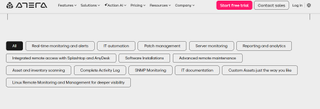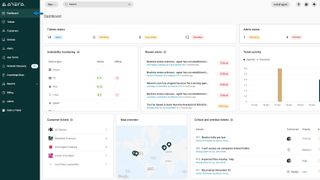Atera
is
RMM
and
PSA
software
that
allows
businesses
and
Managed
Service
Providers
(MSPs)
to
manage
endpoints
for
various
clients.
Unlike
other
RMM
platforms,
Atera
charges
you
on
the
basis
of
the
number
of
technicians
you
have,
rather
than
the
endpoints.
It
also
offers
an
AI
assistant
that
helps
you
automate
tasks
and
solve
tickets,
setting
it
apart
from
others
in
the
industry.
At
the
time
of
writing,
over
12,000
customers,
including
Domino’s,
Sodexo,
and
Grant
Thornton,
use
Atera
to
manage
around
5
million
devices.
In
this
in-depth
Atera
review,
we’ll
discuss
its
primary
features,
pricing,
and
overall
performance.
We’ll
also
compare
it
with
the
competition
to
help
you
find
out
if
it’s
the
right
choice
for
your
business
Atera:
Plans
and
pricing
Atera’s
pricing
structure
is
different
from
other
RMM
software
on
the
market.
It
bills
users
on
the
basis
of
the
number
of
technicians
—
instead
of
the
number
of
endpoint
systems
managed.
This
is
beneficial
for
small
businesses
or
MSPs
where
only
a
few
technicians
handle
the
entire
endpoint
management.
There
are
two
types
of
plans
with
Atera:
one
for
IT
departments
and
the
other
for
MSPs.
to
scroll
horizontally
|
For IT Departments |
Header Cell – Column 1 |
For MSPs |
Header Cell – Column 3 |
|---|---|---|---|
|
Plan Name |
Cost/technician/month (billed monthly) |
Plan Name |
Cost/technician/month (billed monthly) |
| Professional | $149 | Pro | $129 |
| Expert | $189 | Growth | $179 |
| Master | $219 | Power | $209 |
| Enterprise |
Custom pricing | Superpower |
Custom pricing |
For
instance,
let’s
say
you’re
an
MSP
handling
50
systems.
If
you
choose
an
endpoint-based
pricing
structure,
you
can
expect
to
pay
anywhere
between
$150-500
per
month
($2-10
per
endpoint).
However,
with
Atera,
you’d
only
pay
$258
for
50
endpoints
(considering
two
technicians).
Plus,
Atera
goes
beyond
traditional
RMM
functions
and
offers
features
like
remote
access,
helpdesk
and
ticketing,
network
discovery,
and
patch
management.
This
makes
it
a
good
value-for-money
business
tool
for
system
monitoring.
There’s
also
a
30-day
free
trial,
which
you
can
avail
of
without
entering
your
credit
card
details.
This
will
allow
you
to
try
it
out
without
risking
a
single
penny.
A
downside
of
Atera
is
that
its
Action
AI
doesn’t
come
included
with
any
of
the
subscriptions
–
you’ll
have
to
contact
the
sales
team
to
get
a
custom
quote
for
this
add-on.
Atera:
Features

(Image
credit:
Atera)
Atera
lets
you
monitor
system
activities
in
real
time
and
also
offers
automated
alerts.
You
can
get
live
data
on
metrics
like
system
resources,
logged-in
users,
network
and
IP
health,
and
active
directories,
among
others.
Action
AI
A
feature
that
truly
sets
Atera
apart
from
the
competition
is
its
Action
AI,
available
for
both
technicians
(Copilot)
and
end
users
(Autopilot).
Let’s
say
you’re
an
end
user
and
facing
issues
with
your
printer.
All
you
have
to
do
is
open
Autopilot
on
your
device
and
describe
your
problem
using
a
simple
text.
The
AI
assistant
will
then
run
a
check
and
suggest
solutions.
Next,
you
can
click
on
the
solution
option
to
fix
the
issue.
This
saves
a
lot
of
time
for
technicians
and
end
users,
saving
them
the
ordeal
of
raising
a
ticket,
establishing
a
remote
connection,
and
then
fixing
the
issue.
With
Atera,
the
entire
problem
can
be
solved
by
the
end-point
user
himself.
The
Copilot
for
technicians
also
works
similarly.
It
can
look
for
issues
on
the
system
and
help
you
resolve
the
problem
with
just
a
click.
However,
since
this
is
a
paid
add-on,
it
can
increase
the
overall
cost
of
system
management.
Automation
Besides
this,
you
can
also
automate
a
lot
of
redundant
tasks,
so
your
team
can
focus
on
more
critical
functions.
For
instance,
routine
tasks
like
deleting
temp
files,
rebooting
systems,
running
full
system
scans,
and
checking
new
updates
can
be
handled
automatically
by
Atera
with
the
help
of
Scripts.
Scripts
are
simple
commands
that
help
IT
teams
automate
various
processes.
With
Atera,
you
can
either
upload
a
custom
script
or
choose
one
from
its
vast
Shared
Script
Library.
These
readymade
scripts
can
be
further
customized
to
suit
your
task.
Even
better,
these
are
routinely
checked
for
malware
by
Atera,
making
them
safe
to
use.
The
platform
supports
formats
such
as
MSI,
Bash
files,
CMD
files,
and
PowerShell.
All
connected
devices
get
their
own
Customer
Portal,
which
can
be
used
to
raise
service
tickets.
These
tickets
are
automatically
synced
with
the
Atera
UI.
The
platform
has
also
introduced
AI
ticker
tagging,
which
recognizes
support
tickets
based
on
keywords
and
auto-assigns
them
to
the
right
technician
for
quicker
response.
You
can
even
pull
automated
reports
from
Atera,
which
shows
you
metrics
like
total
tickets
resolved
and
average
time
taken
to
resolve
issues.
This
helps
gauge
overall
customer
satisfaction
and
technician
performance.
Patch
management
Another
area
where
Atera
does
an
excellent
job
is
patch
management,
which
allows
you
to
ensure
that
the
software,
hardware,
and
OS
on
your
connected
devices
(Windows,
MacOS,
and
Linux)
are
up
to
date.
You
can
even
automate
patching
and
set
schedules
to
regularly
check
for
updates.
Tasks
such
as
disk
defrag,
scheduled
reset,
and
cleanups
can
also
be
automated.
The
Patch
Status
Summary
report
shows
you
a
summary
of
all
patches
and
updates
for
servers
as
well
as
desktops.
This
way,
you
can
quickly
find
out
if
any
patches
are
missing.
Network
Discovery
Atera
also
offers
robust
Network
Discovery
features
that
allow
you
to
identify
all
the
devices
within
a
given
network
and
simplify
onboarding.
This
also
gives
you
a
detailed
view
of
the
network
topology
and
efficient
network
management.
You
can
even
set
up
custom
alerts
for
unmonitored
servers,
workstations,
and
SNMPs,
and
keep
an
eye
on
new
devices
and
IP
address
changes.
Integrations
Last
but
not
least,
we
were
also
impressed
by
the
sheer
number
of
integration
options
Atera
offers.
You
can
connect
with
Splashtop,
AnyDesk,
or
TeamViewer
to
access
systems
remotely.
Several
accounting
integrations
such
as
QuickBooks
and
Xero
and
Calendar
integrations
like
Google
Calendar
and
Microsoft
365
Calendar
are
also
available.
Atera:
Interface
and
performance
Atera’s
dashboard
serves
as
a
single
source
of
truth
for
technicians,
with
various
widgets
providing
critical
information
on
connected
endpoints.
For
instance,
you
can
check
the
live
status
of
tickets:
open,
pending,
due
today,
or
overdue.
Similarly,
you
can
also
see
the
number
of
alerts
per
customer,
divided
into
three
categories:
‘Information’,
‘Warning’,
and
‘Critical’.
There’s
a
widget
showing
you
the
number
of
online
and
offline
devices
and
a
map
widget
with
the
exact
location
of
all
managed
devices.

(Image
credit:
Atera)
We
also
found
a
couple
of
bar
charts
showing
the
number
of
tickets
opened
and
resolved
over
the
past
7
days.
The
best
part
is
that
you
can
fully
customize
your
dashboard:
add,
delete,
or
resize
widgets
as
per
your
preference.
Plus,
there’s
a
panel
on
the
left-hand
side
with
detailed
information
on
tickets,
customers,
devices,
and
alerts.
Overall,
the
interface
is
clean
and
easy
to
navigate,
with
no
performance
lags.
Atera:
Security
Atera
is
a
secure
RMM
and
PSA
platform,
as
it
complies
with
ISO/IEC
27001,
27017,
27018,
and
27032,
SOC
2
Type
2,
GDPR,
and
HIPAA.
Although
Atera
is
not
subject
to
PCI-DSS
compliances,
it
still
complies
with
them
to
protect
its
customers’
card
details.
Additionally,
the
platform
maintains
detailed
audit
logs
for
account
establishment
and
modifications,
and
you
can
also
add
multi-factor
authentication
to
your
accounts
for
increased
security.
What’s
more,
managers
can
choose
to
impose
role-based
access
control
(RBAC)
across
devices.
All
your
data
on
Atera
is
encrypted
using
industry-standard
and
rock-solid
AES-256
encryption.
It’s
also
worth
noting
that
although
Atera
uses
third-party
tech
for
its
AI
functions,
it
doesn’t
share
any
customer
data
nor
does
it
use
that
data
for
training
its
own
systems.
Atera:
Support
Atera
has
a
rich
collection
of
training
videos
and
articles
and
its
web
knowledgebase
has
several
FAQs
on
topics
like
RMM,
ticketing,
billing,
and
reporting.
Plus,
Atera’s
YouTube
channel
has
50+
useful
videos
that
will
familiarize
you
with
the
product.
Atera
also
offers
24/7
email
and
live
chat
support,
and
there’s
also
an
online
form
you
can
fill
out
for
pre-purchase
queries.
Overall,
there’s
no
dearth
of
support
options
on
Atera.
Atera:
The
competition
Atera
is
ideal
for
small
businesses
and
Managed
Service
Providers
(MSPs)
since
it
offers
a
per-technician
pricing
model
instead
of
a
per-end
point,
which
reduces
the
overall
cost
of
management.
However,
large
businesses
involving
complex
infrastructures
may
find
Atera
expensive.
In
that
case,
you
can
consider
alternatives
like
NinjaOne.
Although
you’ll
have
to
contact
their
sales
team
for
an
exact
quote,
you
can
expect
to
pay
$2-4
per
endpoint.
You
also
get
100+
monitoring
templates
with
NinjaOne,
which
is
the
number
one
patch
management
tool
as
of
the
G2
Spring
2024
report.
On
the
other
hand,
if
you’re
a
small
business
looking
for
a
really
affordable
RMM
product,
consider
TeamViewer.
It
offers
a
free
plan,
where
you
can
connect
unlimited
non-work
devices.
Plus,
it’s
easy
to
set
up
and
use,
making
it
ideal
for
beginners.
Atera:
Final
verdict
Atera
is
certainly
among
the
best
RMM
software
out
there,
thanks
to
its
AI
assistant
and
easy-to-use
and
customizable
dashboard.
Atera’s
Action
AI
(Copilot
and
Autopilot)
helps
solve
redundant
and
frequent
system
queries
quickly
so
that
technicians
can
focus
on
the
complex
issues
at
hand.
Its
per-technician
pricing
model
makes
it
affordable
for
small
businesses
and
MSPs.
The
best
part
is
that
Atera
extends
its
functions
beyond
just
remote
system
management
and
allows
full-fledged
helpdesk,
billing,
and
reporting
functions,
besides
robust
patch
management,
and
network
discovery.
We
also
like
that
it
also
offers
ample
integrations
with
existing
business
tools.
That
said,
Atera
can
quickly
become
expensive
for
large
businesses,
where
specialized
technicians
handle
only
a
few
complex
systems.
In
that
case,
an
endpoint-based
pricing
structure
would
be
ideal.
Atera:
FAQs
How
much
does
Atera
RMM
cost?
Atera’s
offers
two
sets
of
plans:
one
for
IT
departments
and
the
other
for
MSPs.
The
cheapest
plan
costs
$129/technician/month.
Instead
of
charging
users
on
the
basis
of
the
number
of
endpoints
managed,
Atera
charges
them
per
technician
managing
endpoints.
This
means
that
even
if
you
have
50
endpoints
managed
by
a
single
technician,
you
only
have
to
pay
$129/month.
This
makes
Atera
affordable
for
small
businesses
and
MSPs.
What
sets
Atera
apart
from
other
RMMs?
Atera
incorporates
AI
assistants
for
technicians
and
endpoint
users,
which
saves
a
lot
of
time
for
both
parties.
Users
can
use
Autopilot
to
identify
and
solve
regular
queries
at
the
system
level
itself,
without
raising
any
support
ticket.
Similarly,
technicians
can
use
Copilot
to
identify
issues
with
a
given
ticket
and
resolve
them
with
just
a
click
of
a
button.
Furthermore,
the
AI
assistant
can
also
help
auto-assign
tickets
to
the
right
agent
based
on
keywords,
which
ensures
faster
resolutions.
What
aspects
can
I
monitor
with
Atera?
Some
of
the
many
metrics
you
can
track
with
the
Atera
agent
on
your
Windows,
Mac,
and
Linux
systems
include
RAM,
motherboard
and
hard
disk
usage,
overheating
issues,
current
load
on
CPU
and
temperature,
and
Windows
services,
events,
and
processes.
